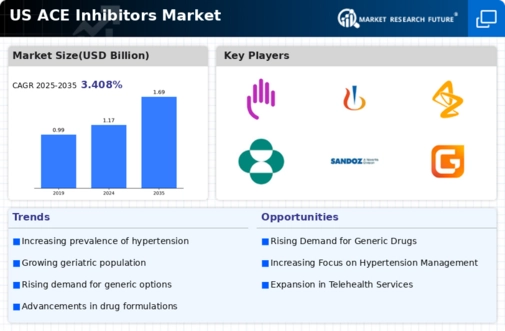Increasing Aging Population
The ace inhibitors market is experiencing growth due to the increasing aging population in the United States. As individuals age, the prevalence of hypertension and heart-related ailments rises, leading to a higher demand for effective treatments. According to the U.S. Census Bureau, by 2030, approximately 20% of the population will be 65 years or older. This demographic shift is likely to drive the need for medications such as ACE inhibitors, which are commonly prescribed for managing high blood pressure and heart failure. The aging population's health concerns are expected to significantly influence the ace inhibitors market, as healthcare providers seek to address the growing burden of cardiovascular diseases among older adults.
Advancements in Telemedicine
The rise of telemedicine in the United States is transforming the healthcare landscape, potentially benefiting the ace inhibitors market. Telehealth services have expanded access to healthcare, allowing patients to consult with healthcare providers remotely. This convenience may lead to increased diagnosis and treatment of hypertension and related conditions. According to a report from the American Medical Association, telehealth visits surged during recent years, and this trend appears to be continuing. As more patients engage with healthcare providers through telemedicine, the likelihood of receiving prescriptions for ACE inhibitors may increase, thereby driving market growth.
Rising Healthcare Expenditure
Healthcare expenditure in the United States continues to rise, which positively impacts the ace inhibitors market. The Centers for Medicare & Medicaid Services (CMS) projects that national health spending will reach nearly $6 trillion by 2027, accounting for approximately 19.7% of the GDP. This increase in spending allows for greater access to medications, including ACE inhibitors, as healthcare providers are more likely to prescribe these treatments to manage chronic conditions. Furthermore, the expansion of insurance coverage and the introduction of value-based care models may enhance patient access to necessary medications, thereby driving growth in the ace inhibitors market.
Focus on Preventive Healthcare
The shift towards preventive healthcare in the United States is influencing the ace inhibitors market. Healthcare systems are increasingly prioritizing preventive measures to reduce the incidence of chronic diseases, including hypertension. This focus encourages early diagnosis and treatment, which may lead to a higher utilization of ACE inhibitors as a preventive strategy. The U.S. Preventive Services Task Force recommends regular blood pressure screenings, which can facilitate timely interventions. As healthcare providers adopt preventive approaches, the demand for effective medications like ACE inhibitors is likely to grow, contributing to the overall expansion of the market.
Growing Awareness of Hypertension
There is a growing awareness of hypertension and its associated risks among the U.S. population, which is likely to bolster the ace inhibitors market. Public health campaigns and educational initiatives have increased knowledge about the importance of blood pressure management. The American Heart Association reports that nearly half of U.S. adults have hypertension, yet many remain undiagnosed or untreated. This awareness encourages individuals to seek medical advice and treatment, leading to higher prescriptions of ACE inhibitors. As healthcare providers emphasize the importance of managing hypertension, the demand for effective pharmacological interventions is expected to rise, positively influencing the ace inhibitors market.

















Leave a Comment